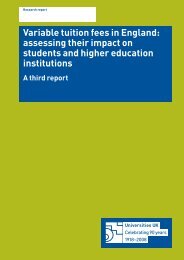Part-time Students And part-time Study In Higher ... - Universities UK
Part-time Students And part-time Study In Higher ... - Universities UK
Part-time Students And part-time Study In Higher ... - Universities UK
Create successful ePaper yourself
Turn your PDF publications into a flip-book with our unique Google optimized e-Paper software.
1 <strong>In</strong>troductionThis report is about the aspirations and experience of <strong>part</strong>-<strong>time</strong> students in the <strong>UK</strong>. It is based on astudy commissioned by <strong>Universities</strong> <strong>UK</strong> and GuildHE (previously SCOP) now and conducted byProfessor Claire Callender of London South Bank University, the Policy Studies <strong>In</strong>stitute, and GfKNOP.1.1 The policy context<strong>In</strong> 2002/03, 42 per cent of all higher education (HE) students in the <strong>UK</strong> were studying <strong>part</strong>-<strong>time</strong> andthis proportion dropped to 34 per cent amongst undergraduate students, which amounted to overhalf a million people. Evidence suggests that they are a growing element of the sector both in termsof their number and their diversity. For instance, between 1997/98 and 2003/04 <strong>part</strong>-<strong>time</strong> provisionhas grown by 45 per cent while full-<strong>time</strong> provision has grown by 12 per cent.Issues about <strong>part</strong>-<strong>time</strong> students, however, were largely overlooked in recent debates about studentfunding including the 2003 White Paper The Future of <strong>Higher</strong> Education (DfES, 2003) and thesubsequent legislation. The references to <strong>part</strong>-<strong>time</strong> students in the White Paper were in relation tothe need for more flexible provision to meet the skills gap. Yet, there was no detailed examination ofthe <strong>part</strong>-<strong>time</strong> student population and the issues concerning them. Nor was there discussion aboutwhat is needed to ensure greater flexibility of provision such as a national credit framework, or creditaccumulation transfer systems.This did not go unnoticed by the House of Commons Education Select Committee. <strong>In</strong> their report onthe White Paper (Fifth Report of Session 2002-03 HC 425-1) they commented:The White Paper is principally concerned with young, full-<strong>time</strong> students. The needs of those who falloutside that category must be properly taken into account if the higher education sector is to providetruly improved access (HC 425-1 p49).Similarly, <strong>part</strong>-<strong>time</strong> students were absent from the accompanying document to the White Paper –Widening <strong>Part</strong>icipation in <strong>Higher</strong> Education (DfES, 2003a). Nor do <strong>part</strong>-<strong>time</strong> students fall within theremit of Office of Fair Access (OFFA), which was set up by the 2004 <strong>Higher</strong> Education Act to ensure“the introduction of variable fees does not have a detrimental effect on widening <strong>part</strong>icipation”(http://www.offa.org.uk/about/ – accessed April 2006). However, the nature of OFFA’sresponsibilities means that no consideration is given to what impact, if any, higher tuition fees for full<strong>time</strong>students may have on <strong>part</strong>-<strong>time</strong> provision and <strong>part</strong>-<strong>time</strong> fees.Yet, the changes in student funding encapsulated in the 2004 Act, <strong>part</strong>icularly the introduction ofvariable fees of up to £3,000 a year repayable on graduation, are likely to have implications for <strong>part</strong><strong>time</strong>students throughout the <strong>UK</strong>. Historically, the fees of <strong>part</strong>-<strong>time</strong> students have been linked on apro-rata basis to those of full-<strong>time</strong> students. With the rise in full-<strong>time</strong> students’ tuition fees in 2006 inEngland and the following year in Wales, it is unclear if this link can be maintained in the future andwhether the <strong>part</strong>-<strong>time</strong> market could sustain large increases in tuition fees, without some changes instudent support for <strong>part</strong>-<strong>time</strong> students.<strong>Part</strong>-<strong>time</strong> students and <strong>part</strong>-<strong>time</strong> study: Strand 3 <strong>Universities</strong> <strong>UK</strong> 8
















